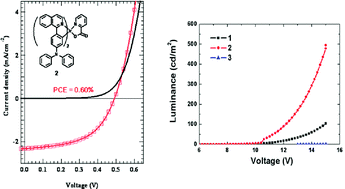Effect of main ligands on organic photovoltaic performance of Ir(iii) complexes†
Abstract
The photovoltaic performance of devices fabricated using three iridium complexes (1, 2, and 3) containing different main

* Corresponding authors
a
Department of Chemistry, College of Natural Sciences, Seoul National University, Seoul, Korea
E-mail:
jihong@snu.ac.kr
Fax: +82-2-889-1568
Tel: +82-2-880-6682
b School of Chemistry, Bio21 Institute, University of Melbourne, Parkville, Victoria 3010, Australia
c
School of Electrical Engineering and Computer Science, Inter-University Semiconductor Research Center, Seoul National University, Seoul 151-742, Korea
E-mail:
chlee7@snu.ac.kr
The photovoltaic performance of devices fabricated using three iridium complexes (1, 2, and 3) containing different main

 Please wait while we load your content...
Something went wrong. Try again?
Please wait while we load your content...
Something went wrong. Try again?
W. Lee, T. Kwon, J. Kwon, J. Kim, C. Lee and J. Hong, New J. Chem., 2011, 35, 2557 DOI: 10.1039/C1NJ20446G
To request permission to reproduce material from this article, please go to the Copyright Clearance Center request page.
If you are an author contributing to an RSC publication, you do not need to request permission provided correct acknowledgement is given.
If you are the author of this article, you do not need to request permission to reproduce figures and diagrams provided correct acknowledgement is given. If you want to reproduce the whole article in a third-party publication (excluding your thesis/dissertation for which permission is not required) please go to the Copyright Clearance Center request page.
Read more about how to correctly acknowledge RSC content.
 Fetching data from CrossRef.
Fetching data from CrossRef.
This may take some time to load.
Loading related content
